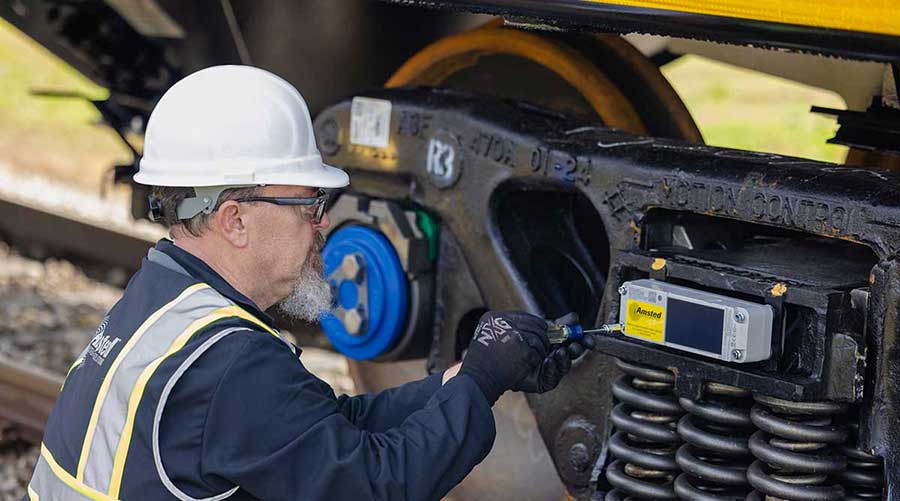Stay updated on news, articles and information for the rail industry
October 2016
Part 1 : Election 2016: What's at stake for rail?
Part 2 : APTA: Local elections put transit funding to the test
Rail News: Rail Industry TrendsAPTA: Local elections put transit funding to the test
By Julie Sneider, Senior Associate Editor
The U.S. presidential and congressional elections aren’t the only votes that public transportation advocates will be watching on Nov. 8: A total of $200 billion in transit initiatives are at stake on local ballots in 31 cities, counties and states.
The ballot measures ask voters to approve proposed increases in taxes or fees to help pay for public transportation in their communities, according to the American Public Transportation Association (APTA).
If the measures pass, the proceeds will go toward improving existing service and expanding transit systems. The largest local transit initiative on the ballot will be in Los Angeles, where voters will be asked to approve Measure M, a half-cent sales tax increase that Los Angeles County Metropolitan Transportation Authority leaders hope will generate enough funds for a $120 billion expansion of the transit system to accommodate the region’s future population growth. Other communities with transit-funding measures on the Nov. 8 ballot and the amount they’re asking voters to approve include Seattle, $54 billion; San Diego, $7.5 billion; San Francisco, $3.5 billion; Santa Clara County, Calif., $3 billion; and Atlanta, $2.5 billion.
“With approximately $200 billion in funding for public transportation, this [election] is a game changer for people and the communities they live in,” said Richard White, APTA’s acting president and chief executive officer during a media conference call held during the association’s annual meeting in September.
White noted that the ballot initiatives will help local communities keep up with the cost of local transportation infrastructure, especially at a time when Congress isn’t always clear about whether it will come through with additional funding for major infrastructure needs.
Economic benefits
The number of ballot measures in November is due in part to transit’s popularity, with transit ridership at an all time high in many areas, according to APTA. Communities see economic advantages, as well: Every $1 invested in public transportation produces about $4 in economic benefits, APTA officials say. Plus, many riders use transit to get to work: Six out of 10 trips on public transportation systems are work-related commutes, according to APTA. Also, riding the subway or other forms of transit can save individuals money — up to $10,000 annually — over the cost of owning and driving a car.
Whether voters in all 31 communities approve the ballot initiatives remains to be seen, of course. But during the media call, White emphasized that transit initiatives have had a good track record. Since 2000, public transit ballot initiatives have passed by an average of more than 70 percent, according to APTA.
“When people understand how a ballot initiative will improve their community’s transportation network, they overwhelmingly vote to support the suggested funding,” White noted in a recent APTA press release.
But even if all 31 ballot measures pass, U.S. public transit executives hope that the next Congress and president will be open to new investment in major transportation infrastructure projects. (Both presidential candidates Hillary Clinton and Donald Trump have indicated support for large increases in infrastructure spending.)
However, during the GOP convention in July, APTA issued a strong statement in opposition to a GOP platform measure that called for ending dedicated federal revenue for public transportation by eliminating mass transit dollars in the federal Highway Trust Fund. Such a move would “undo more than 30 years of overwhelming support for dedicated federal investment in public transit,” White said in a prepared statement in July.
“Having no federal funds would be devastating, not only to the millions of Americans who use public transportation and to the employers who depend on it for their employees, but also for communities of all sizes that need it for a thriving economy and quality of life,” he said.
 Rail-Car Outlook '25: Definitely not 'Back to the Future' anytime soon — forecast by Richard Kloster
Rail-Car Outlook '25: Definitely not 'Back to the Future' anytime soon — forecast by Richard KlosterKeywords
Browse articles on American Public Transportation Association (APTA) Los Angeles County Metropolitan Transportation Authority (LA Metro) Richard WhiteContact Progressive Railroading editorial staff.


 LRW Honors Amtrak’s Acheson As Railway Woman Of The Year
LRW Honors Amtrak’s Acheson As Railway Woman Of The Year
 From Editor-In-Chief Foran: Of Gender Equity And Inclusion
From Editor-In-Chief Foran: Of Gender Equity And Inclusion
 Spotlight On Some Of Today’s Rail Safety Products
Spotlight On Some Of Today’s Rail Safety Products
 Women of Influence in Rail eBook
Women of Influence in Rail eBook
 railPrime
railPrime





